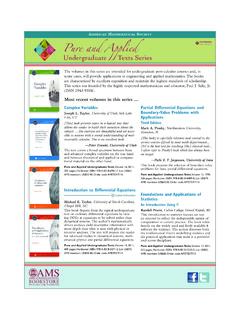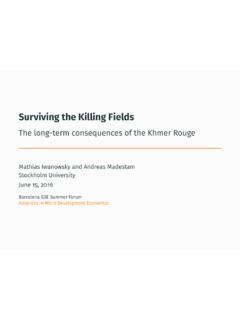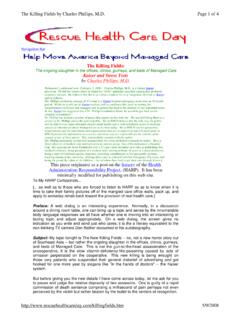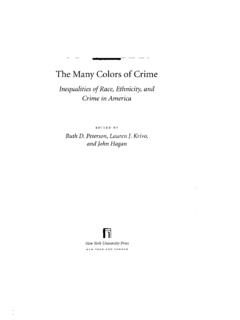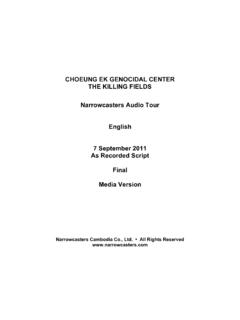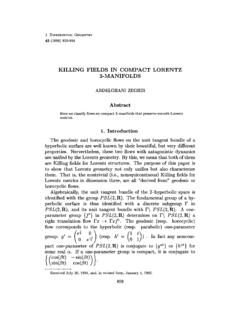Transcription of MANIFOLDS OF NEGATIVE CURVATURE - American …
1 Transactions of the American mathematical society Volume 145, November 1969. MANIFOLDS OF NEGATIVE CURVATURE . BY. R. L. BISHOP AND B. O'NEILLO. 1. Introduction ACm function/on a riemannian manifold M is convex provided its hessian (second covariant differential) is positive semidefinite, or equivalently if (/o <t)"5:0 for every geodesic a in M. We shall apply this notion in a variety of ways to the study of MANIFOLDS of NEGATIVE or nonpositive CURVATURE . Convexity has, of course, long been associated with NEGATIVE CURVATURE , but convex functions seem to have been used only locally or along curves. In the first part of this paper we give an abstract global treatment. Nonconstant convex functions exist only on MANIFOLDS of infinite volume ( ); the first question about such a function on M (complete, A' 0) is whether it has a critical point necessarily an absolute minimum.
2 If not, M is diffeomorphic to a product LxR1 ( ). If so, much of the topology and geometry of M is determined by the minimum set C of/. This comes about as follows. Like any set {me M \ f(m)f a}, C is totally convex, that is, contains a geodesic segment a whenever it contains the endpoints of a. Let A he an arbitrary closed, totally convex set in M. In case A is a sub- manifold, it is totally geodesic and M is, via exponentiation, its normal bundle ( ). This situation does not change greatly if A is not a submanifold ( , );. A is always a topological manifold with boundary (possibly nonsmooth), whose interior is a locally totally geodesic submanifold. We describe a number of geo- metrically significant ways of constructing convex functions ( , , , , etc.);. these show in particular that C may or may not be a submanifold. In the second part of the paper we define and study the mobility sequence of a nonpositive CURVATURE manifold M.
3 The basic fact is that the set P(M) of common zeroes of all killing fields on M is a closed, totally convex submanifold ( ). Thus M is a vector bundle over P(M), which is totally geodesic and hence again has K^O. The mobility sequence is then constructed by iteration: M^ *P(M)^. - - Pk(M)=Q. It terminates with a submanifold that is either mobile (P(Q). empty) or immobile (P(Q) = Q). We prove that if Q is mobile, or if ttx(M) has nontrivial center, then (with a trivial exception) M is a product LxR1 and if also M contains a closed geodesic then in particular M is a vector bundle over a circle ( , ). Since P(M) is invariant under all isometries of M, the mobility sequence is closely related to the isometry group of M ( ). We introduce the notion of warped product (or, more generally, warped bundle), Received by the editors December 16, 1968 and, in revised form, April 7, 1969.
4 (') Research supported in part by NSF grants. Copyright 1969, American Mathematical Society 1. License or copyright restrictions may apply to redistribution; see 2 R. L. BISHOP AND B. O'NEILL [November which uses convex functions to construct a wide variety of MANIFOLDS of NEGATIVE CURVATURE ( ). For example, NEGATIVE space forms can easily be constructed in this way from flat space forms ( ). The study of killing fields on warped products ( ) shows in particular that the dimensions and length of mobility sequences are restricted by only the most trivial necessary conditions ( ). In the final part of the paper we investigate the fundamental group and for the principal results require strictly NEGATIVE CURVATURE , K^c<0. We begin by relating convex functions to asymptotic geodesies, showing for example that if M admits a strictly convex function without minimum (and is not simply connected) then there is a unique equivalence class of asymptotic geodesies with properties decisive for the geometry of M ( ).]
5 Our main tool in the study of the fundamental group is the notion of ray group: fix a point me M, then associated with each geodesic ray p starting at m is a subgroup of - Tr(M)consisting of those elements that (roughly speaking) decrease in length as they move out p. There are two types of such ray groups, depending on whether the ray diverges or has a limit cycle ( ) the latter type are always infinite cyclic. The fundamental group is the disjoint union of its ray groups ( ) and these have the algebraic property that "nontrivial conjugates are disjoint" ( ). In the compact case, for example, our results reduce to a sharpened form ( ) of the Preissmann result that commutative subgroups are cyclic. We assume that riemannian MANIFOLDS and the apparatus on them are C and that MANIFOLDS are connected unless these points are raised. By a closed geodesic y in M we mean a nonconstant periodic geodesic y: A -> M.
6 The closed interval [0, 1] is denoted by I. 2. Convex functions. If/is a C real-valued function on a riemannian manifold M, its hessian V2/= V df is the (0, 2) tensor field such that V2f(X, Y) = XYf-(VxY)f for all vector fields X, Y on M. At each point m e M, V2/is a symmetric bilinear form on the tangent space Mm. If y is a geodesic and y denotes its tangent field , V2/(y',y') = (/ y)". We denote the covariant differential of a vector field X by Ax. Thus Ax is the (1, 1) tensor field for which the value on a vector field Y is AXY=VYX. The following properties of Ax are well known. The symmetry of Ax with respect to the riemannian inner product is equivalent to X being locally a gradient. If Z=grad/, then Ax is the symmetric transformation given by V2/and the metric: V2f(Y, Z) = (AXY, Z>. The skew-symmetry of Ax is equivalent to X being a killing field .)
7 The trace of Ax is the divergence SX of X, that is, the derivative of the volume expansion given by the flow transformations of X. We say that a C function fis strictly convex if, at each pont, V2/is positive definite, and/is convex if, at each point, V2/is positive semidefinite. As we shall see, convex functions arise naturally on MANIFOLDS of nonpositive CURVATURE . License or copyright restrictions may apply to redistribution; see 1969] MANIFOLDS OF NEGATIVE CURVATURE 3. Proposition. Let f be a convex function on a complete riemannian manifold M. Then (1) The critical points of fare its absolute minimum points. (2) For each number c, the set Mc = {me M \ f(m)^c} is totally convex, that is, contains every geodesic segment of M whose endpoints are in Mc. In particular, Mc is connected. (3) / is constant on each closed geodesic in M. (4) For each value c off, the inclusion MC<=M induces a homomorphism of the fundamental group 7r1(Mc) onto tt1(M).
8 Proof. (1) It suffices to show that if p is a critical point, it is an (absolute). minimum point. If m e M, let t. /-> M be a geodesic segment from p to m, and let g=f r. Then g'(0) = 0, since p is a critical point, and g"^0, since/is convex. Hence/(m) -f(p)=g(l)-g(0) 2:0. (2) If t: /-> M is a geodesic segment with/r(0)^c and/r(l)^c, then (/t)"S0. implies /t c. (3) If y is a closed geodesic, then by (2), fy(s) fy(t) for all s, t e R. Thus/y is constant. (4) Each element of tt1(M, m), m e Mc, can be represented by a geodesic loop t at m. But by (2), t lies in Mc. The notion of total convexity obviously differs in an essential way from the usual notion of convexity in a riemannian manifold [1], [2]. For example, in a hyperboloid of revolution the minimal circle is totally convex, but a single point is not. We call attention to the following papers, both appearing contemporaneously in the Annals of Mathematics: D.
9 Gromoll and W. Meyer, MANIFOLDS of positive CURVATURE ; J. Cheeger and D. Gromoll, On the structure of complete MANIFOLDS of nonnegative CURVATURE . The notion of totally convex sets is used in both of these. In the second, it is shown that the inclusion MC<^M above induces a homotopy equivalence; more generally, the same result obtains for a closed totally convex set C such that there are two points p, q in the interior of C for which all geodesic segments from ptoq also lie in the interior of C. This condition is clearly satisfied by Mc. Some of our results below are immediate corollaries; for example, Pro- position (2). However, our proofs are more elementary, since in particular we do not use any Morse theory. Clearly any intersection of totally convex sets is totally convex, and by the argument for (4) above the inclusion map of a totally convex subset into M induces a homomorphism onto of fundamental groups.
10 Except in the case of nonpositive CURVATURE , the proof that this inclusion induces an isomorphism seems to require a Morse theory argument. According to the following proposition, many riemannian MANIFOLDS , in par- ticular the compact ones, do not admit nontrivial convex functions. License or copyright restrictions may apply to redistribution; see 4 R. L. BISHOP AND B. O'NEILL [November Proposition. If M is a complete riemannian manifold having finite volume, then all convex functions on M are constant. Proof. Suppose/is a nonconstant convex function. Let G = grad/and let c be a noncritical value of /. Then cM = {m e M \ f(m)^c} is a submanifold with boundary/" 1(c) and nonzero volume, on which G is never zero and points inward from the boundary. Thus G/||G|| = U is a unit-length field defined on all of CM and "complete upwards" in the sense that the flow transformations {tf>t}of U are defined on all of CM for / 0.]


